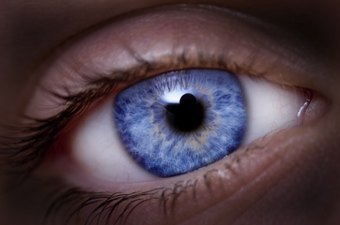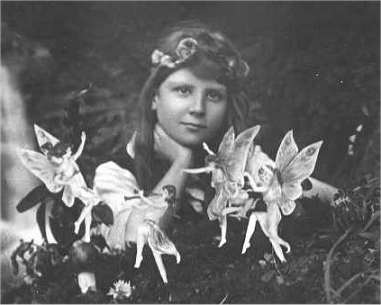A magazine where the digital world meets the real world.
On the web
- Home
- Browse by date
- Browse by topic
- Enter the maze
- Follow our blog
- Follow us on Twitter
- Resources for teachers
- Subscribe
In print
What is cs4fn?
- About us
- Contact us
- Partners
- Privacy and cookies
- Copyright and contributions
- Links to other fun sites
- Complete our questionnaire, give us feedback
Search:
It's in the eyes!
What is the connection between Zhora from Blade Runner and Angelina Jolie? You can spot it in the eyes! ...

Blade Runner: one of the best science fiction films ever. It is the story of Deckard, the "Blade Runner" who takes on the job of tracking down and "retiring" a group of dangerous Replicants that have escaped from Nexus-6.
Replicants are near perfect androids, virtually impossible to tell from humans and a dangerous threat. The only way to be sure someone is not human is to do a "Voight-Kampff" test. This is a little like a lie detector test where the subject is asked a series of questions designed to provoke emotions. By watching minute tell-tale movements in the eyes, a skilled interrogator can tell the real human from the android.
The idea of the Voight-Kampff test probably derives from from the Turing Test: the idea from early Artificial Intelligence research that a way to judge if a true Artificial Intelligence had been created was to ask it questions - but via a third party. If you couldn't tell whether you were talking to a human or not, whichever it was, you ought to accept it to be as intelligent as a human.
The US government must have been watching too many films based on the work of Philip K Dick. They have similar ideas. They are funding research into the idea that terrorists might be caught before they do anything wrong using similar tests that look for minute traces of emotions in a person's face... but that is another story.
Blade Runner has been re-shot, re-edited and generally tampered with to give new versions more than most films. There are seven different "Blade Runner"s to date with the latest 2007 version "Blade Runner: The Final Cut" supposedly the best. Director Ridley Scott has fixed a bunch of things that must have been bugging him for a quarter of a century - cameramen that appeared by accident in the film have been removed; bits where the lip-sync wasn't perfect have been corrected; the spectacular death scene of Zhora (Joanna Cassidy), the Replicant who is shot by Deckard has been fixed. She is flung through a plate glass window. As she is wearing little more than a see-through macintosh, the fact that in the original version she transposed into a hulky stunt not-so-double rather spoiled the shot. That is no more - the stuntman has gone and all that can be seen now is Joanna Cassidy doing her own dying. A perhaps not so good change is that apparently the eyes of the Replicants now occasionally glint, reflecting light oddly, which rather defeats the point of the Voight-Kampff test!
It is rather ironic that Blade Runner, a film about detecting fakes from their eyes, has been doctored so much. Why? Because it turns out that the eyes are a good way to find out whether a photo has been digitally doctored. This is becoming a big problem. Quality newspapers, for example, rely on the authenticity of the photos they use so that they tell the story that really happened. Their job is to tell the news impartially and accurately not to make it up (unlike tabloids who are probably happy to fake if it makes a good story). Increasingly media outlets are being sold photos that turn out to be fake and several photographers have been sacked when fakery has been discovered. Sometimes it may only be celebrities that suffer such as when Angelina Jolie and Brad Pitt were supposedly photographed by Paparazzi together on a beach confirming their relationship. Presumably the photographer was paid a huge amount for such a scoop. Trouble is the picture of Pitt is from 2005 but Jolie's part of the photo was taken in 2004. They were then 'photoshopped' together. Not proof at all. In that case the pair did eventually form a relationship, so perhaps it wasn't so bad. There could have been serious consequences for the lives of others around them like Jolie's child, though. They may be film stars but they are still real people with real feelings and real families and friends. There are always consequences of some kind from such lies.
Who knows what other things you believe from photos that have no basis in truth? After all as I write Wikipedia still seems to be claiming a photo that sounds like the faked one was the first "proof" of their relationship.

Photo lies can have major consequences. For example, presidential candidate John Kerry probably lost lots of votes as a result of a fake photo that was circulated of him apparently at an anti-war concert. Stalin famously made people he had had killed or otherwise 'purged', like Leon Trotsky, 'disappear' from photos as though they had never existed. Another famous case is the Cottingley 'fairies at the bottom of the garden' case, that many people still think is proof of the existence of fairies, including Sir Authur Conan Doyle of Sherlock Holmes fame. Actually it was faked by two cousins playing a prank on their family. The prank just got out of hand.
Adding fairies just required some cut-outs and hat pins. Disappearing someone was more difficult. In Stalin's time it took a great deal of skill and time. Now anyone can do it just with off-the-shelf desktop software.
The result is that there are now Computer Scientists who specialise in detecting doctored photos. Professor Hany Farid of Dartmouth College in the US is one. He pioneered the idea of using the eyes as a way to spot fakes (which brings us back to Replicants!) He is a specialist in the area of digital forensics and the analysis of images and is now heavily in demand to help flush out the fakes.
How do the eyes help? Well your eyes act like tiny mirrors reflecting the light from around you. So if it turns out one person in a picture has light reflected in a different way to another person then it must mean one was digitally added from a different photo or place. That is why the Pitt-Jolie photo is clearly a fake. By using sophisticated algorithms Hany's computer programs can automatically work backwards from the picture and determine where the light sources are. By then detecting areas of a photo where the light is completely different, the parts of the photo that have been doctored can be identified.
Hany has developed a whole series of different methods - he has to as the fakers and their tools are improving all the time too. Another method for example is to look for cloned areas where one area of an image has been copied somewhere else. This is done by breaking up the image into small areas. Each area is then moved to a new position depending on the profile of colours in it. Ones with similar profiles are moved close together. The more different the profile the further apart they are placed. Identical blocks end up together. Then adjacent blocks that are similar in a way that means they could have been cloned are then merged together: highlighting areas that are liable to have been cloned.
In the digital age you can no longer be sure of the evidence before your eyes. A picture on its own is no longer proof...it probably never was. With the help of computer science techniques they are at least now ways to spot the fakes. Replicants may be fiction, but that doesn't mean you can't spot fake humans from their eyes. It's just it only works for 2-dimensional ones.


